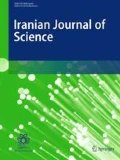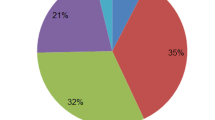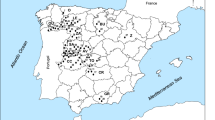Abstract
For hundreds of years, people have used honey, and still are using it, as a natural sweetener and for its multiple health benefits. The quality of honey may be altered by several factors among which processing, storage conditions and falsification. The present study focusses mainly on the characterization of the physicochemical properties of nineteen Algerian honeys belonging to different localities and botanical origins in order to determine their quality and to detect any adulteration. For this purpose, water content, 5-hydroxymethylfurfural content, sugars content, pH, acidity, electrical conductivity and diastase activity were measured. Results indicate that all samples are in compliance with the values set by international standards for all the analysed parameters. In addition, relevant correlations were observed between the different analysed physicochemical properties of the selected honey samples from a part, and with bioclimate of geographical origins from another part. Besides, based on the examined physicochemical parameters, it appears that Z. lotus and Carduus sp. honey samples are characterized by high acidity and sucrose content while Eucalyptus sp. and multifloral honey samples are characterized by an elevated electrical conductivity, 5-hydroxymethylfurfural content and diastase activity. However, Citrus sp. honey samples are characterized mainly by higher content of glucose and fructose and equivalent humidity percentage. Overall, such physicochemical properties could be regarded as useful criterion for honey classification.


Similar content being viewed by others
Data Availability
Data are available on request.
References
Ait Abderrahim L, Taïbi K, Ait Abderrahim C (2017) Assessment of the antimicrobial and antioxidant activities of Ziziphus lotus and Peganum harmala. Iran J Sci Technol Trans Sci 43:409–414. https://doi.org/10.1007/s40995-017-0411-x
Belaid M (1999) Physicochemical and palynological study of some central Algerian honeys: Establishment of standards identification. Dissertation École Nationale Supérieure Agronomique d'Alger, Algeria
Belhaj O, Oumato J, Zrira S (2015) Physico-chemical study of some Moroccan honeys types. Revue Marocaine des Sciences Agronomiques et Vétérinaires 3(3):71–75
Benaziza-Bouchema D, Schweitzer P (2010) The main honeys characterization of the northern regions of Algeria. Cahiers Agri 19(6):432–438. https://doi.org/10.1684/agr.2010.0432
Bogdanov S (2009) Harmonised methods of the International honey commission. http://www.ihc-platform.net/ihcmethods2009.pdf.
Bogdanov S, Ruoff K, Persano Oddo L (2004) Physico-chemical methods for the characterisation of unifloral honeys: a review. Apidologie 35:4–17
Bouhlali EDT, Bammou M, Sellam K, El Midaoui A, Bourkhis B, Ennassir J, Alem C, Filali-Zegzouti Y (2019) Physicochemical properties of eleven monofloral honey samples produced in Morocco. Arab J Basic Appl Sci 26(1):476–487
Boussaid M, Taïbi K, Ait Abderrahim L, Ennajah A (2018a) Genetic diversity of Ziziphus lotus natural populations from Algeria based on fruit morphological markers. Arid Land Res Manag 32(2):184–197
Boussaid A, Chouaibi M, Rezig L, Hellal R, Donsı F, Ferrari G, Hamdi S (2018b) Physicochemical and bioactive properties of six honey samples from various floral origins from Tunisia. Arab J Chem 11:265–274. https://doi.org/10.1016/j.arabjc.2014.08.011
Chefrour A (2008) Algerian Honeys: Physico-chemical characterization and melissopalynology (Case of honeys from eastern Algeria). Dissertation, University of Annaba, Algeria.
Codex Alimentarius Commission (2001) Standard for Honey. International Food Standards
Commission E (2002) Council directive 2001/110/EC of 20 december 2001 relating to honey. Off J Eur Communities L10:47–52
Diacu E, Tantaveanu EF (2007) Determination of moisture content and its correlation with other parameters in honey quality control. Revista de Chimie -Bucharest- Original Edition 58(12):1310
Eteraf-Oskouei T, Najafi M (2013) Traditional and modern uses of natural honey in human diseases: a review. Iran J Basic Med Sci 16(6):731–742
Gonnet M (1986) L’analyse des miels. description de quelques méthodes de contrôle de qualité. Bull Tech Apicole 13(1):17–36
Hadj Said A, Makhloufi C, Choukri A, Davin A (2009) Some honeys characterization from northern Algeria, Revue de lécologie environnement, N 5. Ibn Khaldoun University, Tiaret
Imtara H, Elamine Y, Lyoussi B (2018) Physicochemical characterization and antioxidant activity of Palestinian honey samples. Food Sci Nutr 6:2056–2065
Kaskoniene V, Venskutonis PR (2010) Floral markers in honey of various botanical and geographic origins: a review. Compr Rev Food Sci Food Saf 9:620–634
Louveaux J, Abed L (1984) North African honeys and their pollen spectrum. Apidologie 15(2):145–170
Makhloufi C, Kerkvliet JD, D’Albore GR, Choukri A (2010) Characterization of Algerian honeys by palynological and physico-chemical methods. Apidologie 41:509–521
Makhloufi C, Kerkvliet J, Schweitzer P (2015) Characterisation of some monofloral Algerian honeys by pollen analysis. Grana 54(2):156–166
Makhloufi C, Taïbi K, Ait Abderrahim L (2020) Characterization of invertase and diastase activities, 5-hydroxymethylfurfural content and hydrogen peroxide production of some Algerian honeys. Iran J Sci Technol Trans Sci 44:1295–1302. https://doi.org/10.1007/s40995-020-00936-x
Martysiak- Zurowska D, Borowicz A (2009) A comparison of spectrophotometric winkler method and HPLC technique for determination of 5-hydroxymethylfurfural in natural honey. Chem Analityczna 54:939–947
Mekious S, Houmani Z, Bruneau E, Masseaux C, Guillet A, Hance T (2015) Characterization of honeys produced in the steppic region of Djelfa in Algeria. Biotechnol Agron Soc Environ 19(3):219–229
Nair S, Meddah B, Aoues A (2013) Melissopalynological characterization of north Algerian honeys. Foods 2(1):83–89
Ouchemoukh S, Louaileche H, Schweizer P (2007) Physicochemical characteristics and pollen spectrum of some Algerian honeys. Food Control 18:52–58
Pasias IN, Kiriakou IK, Proestos C (2017) HMF and diastase activity in honeys: a fully validated approach and a chemometric analysis for identification of honey freshness and adulteration. Food Chem 229:425–431. https://doi.org/10.1016/j.foodchem.2017.02.084
Persano Oddo L, Piro R (2004) Main European unifloral honeys: descriptive sheets. Apidologie 35(1):38–81
Prica N, Živkov-Baloš M, Jakšić S, Mihaljev Z, Kartalović B, Babić J, Savić S (2014) Moisture and acidity as indicators of the quality of honey originating from Vojvodina region. Arh Vet Med 7(2):99–109
Ratiu IA, Al-Suod H, Bukowska M, Ligor M, Buszewski B (2020) Correlation study of honey regarding their physicochemical properties and sugars and cyclitols content. Molecules 25(1):34. https://doi.org/10.3390/molecules25010034
Schweitzer P (2000) On the trails of the France’s honeys. the amylase activity of honeys N° 861. Abeille de France, France
Schweitzer P (2003) On the trails of the France’s honeys. physico-chemical analysis of honeys. Abeille de France, France
Schweitzer P (2004) On the trails of the France’s honeys Unusual linden honeys. Abeille de France, France
Sereia MJ, Março PH, Perdoncini MRG, Parpinelli RS, de Lima EG, Anjo FA (2017) Techniques for the evaluation of physicochemical quality and bioactive compounds in honey. In: Toledo VAA (ed) Honey analysis. InTech, Croatia
Sun Z, Zhao L, Cheng N, Xue X, Wu L, Zheng J, Cao W (2017) Identification of botanical origin of Chinese unifloral honeys by free amino acid profiles and chemometric methods. J Pharm Anal 7:317–323. https://doi.org/10.1016/j.jpha.2017.06.009
Terrab A, Diez MJ, Heredia FJ (2002) Characterization of Moroccan unifloral honeys by their physicochemical characteristics. Food Chem 79:373–379
Terrab A, Díez MJ, Heredia FJ (2003) Palynological, physico-chemical and colour characterization of Moroccan honeys: River redgum (Eucalyptus camalduensis Dehnh) honey. Int J Food Sci Tech 38(4):379–386
Thrasyvoulou A, Tananaki C, Goras G, Karazafiris E, Dimou M, Liolios V, Kanelis D, Gounari S (2018) Legislation of honey criteria and standards. J Apic Res 57(1):88–96. https://doi.org/10.1080/00218839.2017.1411181
Tosi E, Martinet R, Ortega M, Lucero H, Ré E (2008) Honey diastase activity modified by heating. Food Chem 106:883–887. https://doi.org/10.1016/j.foodchem.2007.04.025
Yaiche-Achour H, Khali M (2014) Composition physicochimique des miels algériens. détermination des éléments traces et des éléments potentiellement toxiques. Afr Sci 10(2):127–136
Zerrouk SH, Fallico BG, Arena EN, Ballistreri GF, Boughediri LA (2011) Quality evaluation of some honey from the central region of Algeria. Jordan J Biol Sci 4(4):243–248
Zerrouk S, Seijo MC, Escuredo O, Rodríguez-Flores MS (2018) Characterization of Ziziphus lotus (jujube) honey produced in Algeria. J Apic Res 57(1):166–174. https://doi.org/10.1080/00218839.2017.1399663
Živkov-Baloš M, Popov N, Vidaković S, Pelić DL, Miloš Pelić M, Mihaljev Z, Jakšić S (2018) Electrical conductivity and acidity of honey. Arh Vet med 11(1):91–101
Acknowledgements
Authors would like to thank Prof. Paul Schweitzer from CETAM- Lorraine (France) for his kind help and assistance for the melissopalynological identification of honey samples.
Funding
This study was financed solely by the authors own resources, without financial help of any institution.
Author information
Authors and Affiliations
Corresponding author
Ethics declarations
Conflict of interest
The authors declare that there are no known conflicts of interest associated with this publication and there has been no significant financial support for this work that could have influenced its outcome.
Rights and permissions
About this article
Cite this article
Makhloufi, C., Ait Abderrahim, L. & Taibi, K. Characterization of Some Algerian Honeys Belonging to Different Botanical Origins Based on their Physicochemical Properties. Iran J Sci Technol Trans Sci 45, 189–199 (2021). https://doi.org/10.1007/s40995-020-01047-3
Received:
Accepted:
Published:
Issue Date:
DOI: https://doi.org/10.1007/s40995-020-01047-3




